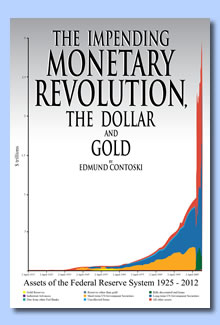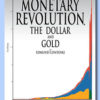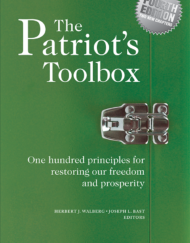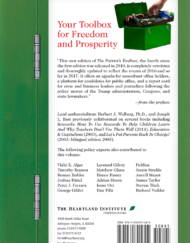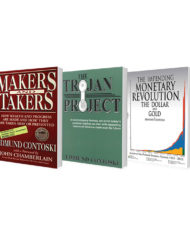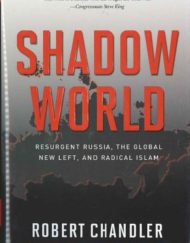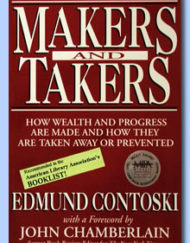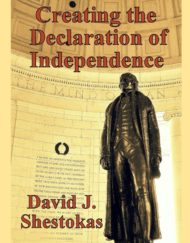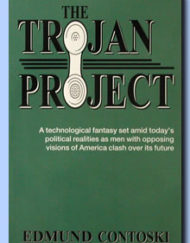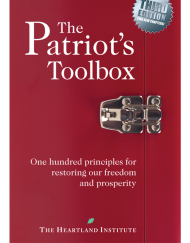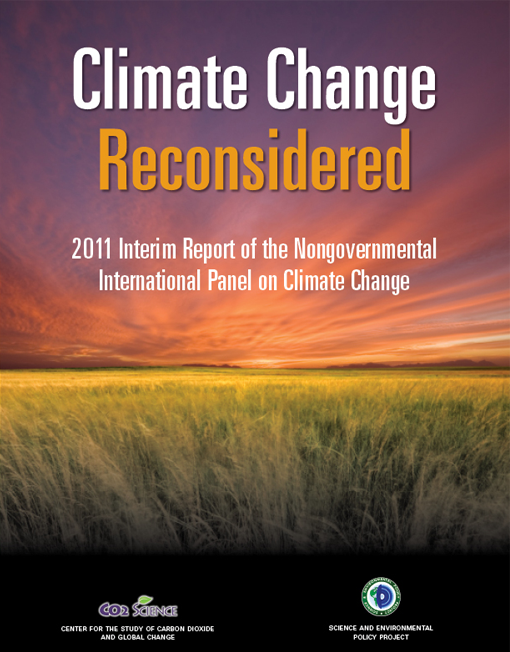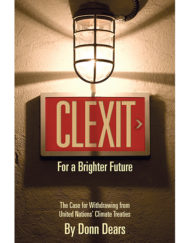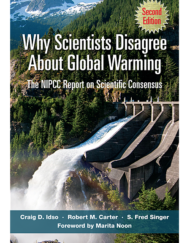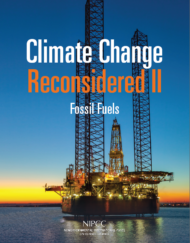Second Edition, ISBN 978-0-9655007-1-5, with SIX NEW CHAPTERS.
The crisis began in a small country, Greece, but it revealed financial vulnerabilities that are overturning the monetary system of the world. For years the Greek government spent beyond its means and borrowed to make up the difference … just like the U.S. government. The United States has not yet suffered the dire economic consequences of Greece because of the dollar’s status as the world’s reserve currency. That means it is the only country in the world that can pay its debts by simply printing more of its own money. Those days will come to an end.
American and European banks have gotten into trouble because of unsound banking practices that would not have been possible under a gold standard. And governments are on the verge of bankruptcy because there is no restraint, which a gold standard would provide, on their spending and manipulation of credit.
American politicians have debauched the currency for agendas contrary to our Constitution and to get themselves elected. And the Federal Reserve has provided a means of financing uneconomic political agendas and pushing the costs onto future generations. But debt and credit cannot expand forever, as America’s housing/mortgage bubble demonstrated. When the credit bubble bursts, hard times must follow.
Eventually sound money will return, because it is necessary. It will be gold because of its intrinsic characteristics and because no government has an unlimited supply of it to keep reckless borrowing and spending growing indefinitely.
If sound money doesn’t return in the United States, it will return somewhere else. Then not only the dollar, but America itself, will lose its primacy in the world. It will lose that primacy as much for the neglect of its original constitutional principles as for the fate of the dollar itself. In fact, it was the neglect of those principles that led to the the frightening expansion of government and the demise of the dollar.
The national debt limit has been raised 77 times since March 1962. Federal spending keeps increasing, and the value of the dollar keeps declining. Today it takes $5.69 to buy what one dollar would buy in 1971. Everyone knows this loss of value should be stopped, yet it continues–even accelerates.
The skyrocketing rise in paper assets of the Federal Reserve, shown on the cover of The Impending Monetary Revolution, the Dollar and Gold, portends an ominous future. This book explains factors, including international ones, that brought us to this point and what must be done to stop impoverishing Americans through monetary manipulations and restore a sound currency.
Arthur Laffer, Ph.D., “the father of supply-side economics,” said
The Impending Monetary Revolution, the Dollar and Gold is “a ray of sunshine in an otherwise bleak world … [of] fiscal cliffs, uncontrolled money creation, all you can eat for a buck healthcare, and European ‘I owe you nothings.’” And Kirkus Review promises “Disciples of Ayn Rand will cheer Contoski’s latest work.”
Reader Elizabeth Barbarick says, “So the big question is, what do we do about this? What will happen in our children’s lifetime? Our grandchildren? Why is unemployment at an all time high? One might say we should return to the gold standard. Read more about this topic and learn something new! I give this book a 5/5.”
For more praise for The Impending Monetary Revolution, the Dollar and Gold, click the Critical Acclaim link at left. You can read the Feathered Quill‘s interview with Contoski here: http://www.amlibpub.com/feathered-quill-interview-2013-05.html
Additional information
| Weight | .75 lbs |
|---|---|
| Dimensions | 9 × 6 × 1 in |
| ISBN | 978-0-9655007-1-5 |
| Year | November 2014 |
| Format | Quality Paperback |
| # of Pages | 281 |
| Illustrations | 33 illustrations with 31 in color |
Edmund Contoski has 45 years experience in international markets. He has lectured widely on international monetary issues and conducted investment seminars in precious metals and foreign currencies. He also has held positions in economic research and world trade, including director of research for a futures commission merchant (FCM).
In addition, Contoski was director of planning and design for one of the largest home building/land development companies in the Chicago area, and planner for the second largest home building company in Minnesota. Finally, he was director of planning for an internationally renowned environmental consulting company doing business in more than 40 countries.
Contoski’s publisher, American Liberty Publishers, was founded 1997 and is dedicated to spreading the ideas of freedom. It is a self-publishing enterprise that makes available the nonfiction and fiction works of Edmund Contoski. These works, which can be purchased online at http://www.amlibpub.com/publications.html, include The Impending Monetary Revolution, the Dollar and Gold, Makers and Takers, The Trojan Project, and The Manifesto of Individualism.
Contoski’s book is “a ray of sunshine in an otherwise bleak world … [of] fiscal cliffs, uncontrolled money creation, all you can eat for a buck healthcare, and European ‘I owe you nothings.’”–Arthur Laffer, Ph.D., the “Father of Supply-Side Economics,” member for eight years of President Ronald Reagan’s Economic Policy Advisory Board, and former chief economist at the Office of Management and Budget. In 2000, Laffer was selected by Time magazine for the cover story of its millennium issue on the 100 most influential people in the twentieth century. In 2009 he was nominated for the Hayek Award. (Hayek won a Nobel Prize in economics.)
“Disciples of Ayn Rand will cheer Contoski’s latest work. A stalwart critic of government intervention in markets, Contoski dissects the Greek debt crisis and sees trouble ahead for America. He argues the U.S. has avoided the Eurozone’s plight since the dollar is the world’s reserve currency. America is the ‘only country in the world that can pay back its borrowings by simply printing more of its own money,’ he writes. But the ever-expanding supply of dollars is not backed by gold, leading Contoski to conclude the dollar is losing an important function of money: store of value. He contends that gold-backed currencies stabilize inflation and exchange rates while fostering higher employment and rising living standards. Our fiat paper money has no intrinsic value. Throw in an activist Federal Reserve and spendthrift government, and it’s no surprise America is drowning in debt and suffering from the effects of credit bubbles. …
“Penned with the sagacity of someone who has spent 45 years studying markets, the text has two main components. One is the author’s cogent analysis of recent economic events that points to a global search for an alternative to the dollar. The other is a philosophical declaration heralded by capitalists everywhere: Free enterprise can do better than governments. A champion of individualism and property rights, Contoski calls for constitutional amendments that would re-establish the gold–dollar link and curtail federal spending. The book is sharply critical of the Obama administration and won’t make friends among Keynesian economists or the political left. Gold contrarians will question Contoski’s faith in the yellow metal. Still, the author writes with an urgency that reflects the nation’s uneasiness about its finances. Contoski believes when the dollar collapses, it will do so swiftly–a doomsayer’s prophecy impossible to be lukewarm about. A frightening vision of the future of the greenback as America’s fiscal time bomb ticks.”–Kirkus Review
“There is a natural cadence and logical procession to the information Contoski delivers–the cadence accredited to his use of simple terminology supported by powerful context and facts. The logical procession is carefully laid out in basic economics again, supported by statistical and historical data. This book tracks the monetary history trail by explaining the development, manipulation, failures and ultimate quest for alternatives to the dollar as it segues into the introduction and importance of gold. There are many indicators through Contoski’s research that support the world’s quest for alternatives to the dollar. This book is not over-infused with statistics or scare tactics. Rather, there is a confident message that resonates as Contoski often cites our founding document, The Declaration of Independence, and the importance of man to be able to exercise his ‘… unalienable rights, that among these are Life, Liberty and the Pursuit of Happiness …’
“The greatest ability I embrace to this day is not only to have learned how to read, but my inherent love of reading. I am honored to render my review of Mr. Contoski’s book for a multitude of reasons. Overall, I commend him because economics has never been one of my strengths. However, after reading The Impending Monetary Revolution, The Dollar and Gold, I want to thank Mr. Contoski. Due to his agility and skill toward word placement (coupled with a tremendous knowledge of his topic), Mr. Contoski has taken the complex subject of finance and economics, laid it out across a mere couple of hundred pages and left me with an unbelievable sense of understanding the topic. His thoroughness in opening the camera lens beyond the economic constraints within the United States to incorporate a global perspective for the reader is fascinating and well documented. I say bravo for the work you put into writing this book Mr. Contoski! The end result is an extremely compelling and informative body of work.”–Diane Lunsford, Feathered Quill Book Reviews. To see Feathered Quill’s interview with the author, go to: Feathered-Quill-Interview-2013-05.html
“Nowhere is the question and issue of trust more essential than the trust of citizens in any nation in the value of their currency. The Impending Monetary Revolution, The Dollar and Gold by Edmund Contoski ($28.95, American Liberty Publishers, Minneapolis, MN, softcover) provides the reader with an historic review of how money, currency, developed over the centuries, from trading furs and tools to today’s paper money. He also provides an easily comprehensible explanation of the ways governments debase their currency while, in past decades, spending too much–mostly on social programs–and relying on the national and international cartels of national banks or, in our case, the Federal Reserve (not part of the federal government, but granted the ability to simply print money without any actual value except trust. It is a very scary book. ‘As of June 2008, the notional amounts (face value) of financial derivatives, according to the Bank for International settlements, totaled $673 trillion–over 12 times the world’s nominal gross domestic product!’ He warns that no nation has ever been able to spend its way to prosperity and, it must be said, that is exactly what the U.S. has tried to do with the failed ‘stimulus’ program and other comparable efforts. If you want to understand what is happening in the U.S. and worldwide, this is the one book you absolutely need to read.”–Alan Caruba in Bookviews
“Other reviews more than adequately touched on the government induced causes of the impending crisis as explained by Mr. Contoski. What particularly separates this book from the herd is his conclusion. The solution, if any, can only come through the states via an Article V amendment convention. The first item of business should be repeal of the 17th Amendment, the renewal of federalism. Until power is once again divided vertically between the states and federal government, no restoration of liberty and property is possible.”–Rod Dodsworth
“Edmund Contoski has written a rigorous and comprehensive examination of the origin of money from ancient times to the present day monetary systems in use throughout the world. Historically, money has been based on precious metals, primarily gold, but in recent times, money has little or no intrinsic value and is referred to as fiat money. He has provided many examples of current financial disasters across the globe in countries like Greece, Ireland, Portugal, Spain, etc., as well as an impending financial crisis facing America. The failures of fiscal responsibility and the related disaster of high inflation tell us that something must be done to reverse this trend. Our Federal Reserve System allows us to print money and increase the supply of money in order to pay debts, but this only devalues the dollar and robs people of their savings. The Federal Reserve benefits a few and hurts the rest of us. It is time to establish the gold standard and do away with the Federal Reserve in America. This can be accomplished by the states getting involved in the constitutional amendment process as authorized by Article V of the Constitution to make appropriate amendments that otherwise will not be initiated by Congress. We must make our state legislators aware of this urgent need and take action without delay. Wake Up, America!: Understand the US Constitution and Get Involved.”–Frank E. Sisson
“Investment lecturer Edmund Contoski presents The Impending Monetary Revolution, The Dollar and Gold, a wake-up call about what the severe fiscal problems rocking Europe and especially Greece imply about America’s troubling debt problems. The American dollar enjoys the high status of being the world’s reserve currency, and the American government currently has the option of printing more money to answer its debts. Contoski warns that both these situations will soon change, and criticizes the reckless gambling that modern banking has become under the fractional reserve system. A return to the gold standard would make impossible some of the worst shenanigans that precipitated the financial crises of 2008 onward, and so Contoski argues heavily in favor of such a measure, to the extent of claiming it will inevitably become necessary. A wealth of data and numerous full-color charts and graphs offer supporting evidence for Contoski’s thesis on why he believes the gold standard is part of the antidote to reckless government expansion, excessive debt, and the threat of hyperinflation. ‘Despite growing inflation, the dollar probably won’t be replaced with a new currency, at least not if the Constitution is to be followed… The only other way to get around this Constitutional limitation would be a Constitutional amendment to permit a new currency – one backed by gold. Since there is virtually no chance of such an amendment being initiated by Congress, it would likely have to be done through a new Constitutional convention.’ The Impending Monetary Revolution is an eye-opening and forceful argument, thought-provoking and extremely critical of the Obama administration.”–John Taylor, Reviewer, Midwest Book Review
From Patrick Barron, a consultant to the banking industry. For 30 years he ran a major section of the Graduate School of Banking (associated with the Graduate School of Finance) at the University of Wisconsin.
“Austrian school economist Edmund Contoski has written a welcome addition to his 2012 explanation of the inevitable consequences of forcing fiat money on society. Six additional chapters have been added to his fifteen-chapter 2012 first edition. Not only are readers of the original treated to new material, they are treated to a plan of action. Whereas the first edition laid out the case for commodity based money that arises naturally in the market place (and is well worth rereading), the second edition adds recent monetary insults that have arisen, the logical adverse consequences of these additional insults, and policy fixes. It is the latter addition, the policy fixes, that I found most interesting.
“The author makes clear that policy must change. But what kind of change? The answer is a return to the wisdom of the Founding Fathers. Most readers, including your humble reviewer, will be treated to an in-depth explanation of the principles of federalism that go beyond the separation of powers. Once exposed to their ideas, one cannot but agree that nothing superior to the thoughts of our Founding Fathers has been advanced over the almost two and a half centuries since the Constitution’s adoption by the states. There has been a steady chipping away at our freedoms, which will lead to catastrophe if not reversed.
“Chapter XIX ‘More on Amendments’ is a blueprint for action with the states taking the leading role. Only the states have the resources to counter the federal leviathan. But they must act in unison and with full adherence to the law. The law to which the states must adhere is the Supreme Law of the Land, the Constitution itself. But they must adhere to the Constitution as written and as explained by our Founders at the time of adoption, not by subsequent supposed legal scholars who have found much federal power ‘between the lines’ of the written document. There is much original source material by the Founders upon which the states may depend. Our Constitution is a living document in the sense that the Founders provided the philosophical underpinnings to the real framework of our federal system, which is infinitely adaptable to the challenges of modern life.
“Apologists for a strong central government will miss the point of this book. Americans do want a strong federal government, but we want that strength applied only to the areas of government delegated to it by the states and enumerated in the Constitution. We do want a strong national defense. We do want free trade within our borders. We do want a federal judiciary to which we may appeal when the states overstep their bounds and threaten our liberties. The problem that has existed at least since the Civil War is that there seems to be no appeal when the federal government itself oversteps its bounds. That government’s own court system decides these questions. The states must act in unison to oppose these federal encroachments. I am certain that the author does not ascribe all wisdom to the states, but at least there are fifty states in competition for our productive citizens. A state that adopts perfectly legal but foolish policies will find that it has lost resources to other, wiser states. Currently there is no escape from the federal government’s poor policy choices. This must change!
“Please read Mr. Contoski’s updated book, 2nd edition.”
From Jay Lehr, Ph.D., senior fellow and science director of The Heartland Institute.
“Edmund Contoski’s The Impending Monetary Revolution, the Dollar and Gold is as an important addition to the discussion and understanding of monetary policy and its effects on economies, societies, and individuals.
“The book will improve your understanding of what money is, why the European Union is doomed to failure, why inflation ultimately creates recessions, and why it is impossible for a country to inflate its way out of a recession …
“Probably few readers have a real grasp of the complex financial instrument called the credit default swap. These insurance-like contracts pay buyers when bonds default. CDS prices rise when bonds’ creditworthiness deteriorates. Contoski explains how incredible volumes of these contracts are temporarily propping up bankrupt members of the European Union, and how they became bankrupt.
Seen Long Ago
“The author notes problems of this nature were recognized by Thomas Jefferson and George Washington, who said, ‘Paper money has had the effect in your state that it will ever have, to ruin commerce, oppress the honest and open the door to every species of fraud and injustice.’”
“Washington was speaking of ‘fiat’ money, which is now used in major countries around the world. It’s called fiat because it is created by government order, or fiat. It is paper money that has nothing of real value supporting it, such as gold or silver. The U.S. dollar is a fiat currency.”
“Contoski explains how bank notes and checks simply grew out of receipts given by goldsmiths who were the keepers of the valuable resource in an earlier day. The U.S. Constitution never gave the federal government the power to print paper money, he says, but the government eventually assumed that power.”
“Few people today realize that President Franklin Delano Roosevelt, feeling his administration threatened by the value of gold in the face of the government’s paper money, made it illegal to own gold. Everyone was forced to turn in their gold or risk going to prison.”
“Contoski also tells wonderful contemporary stories of intrigue, such as how a woman working at Goldman Sachs was able to disguise Greece’s debt for several years while collecting $300 million for the effort. JP Morgan worked similar magic for Italy.”
Fannie’s, Freddie’s Failures
“Contoski makes the failures of government mortgage behemoths Fannie Mae and Freddie Mac easy to understand, and he names politicians who created the housing bubble, starting with the Community Reinvestment Act in 1977 and its subsequent amendments, and continuing through the Dodd-Frank Act of 2010.”
“President Richard M. Nixon ended all pretense the dollar was backed by gold in 1971 by unilaterally ending the Bretton Woods Agreement of 1944 that linked the dollar to gold. Nixon did this because some other nations’ governments were stockpiling gold instead of dollars in recognition of the eventual worthlessness of most paper money.”
“Contoski also dismantles the economic theory of Depression-era economist John Maynard Keynes, who argued governments can stimulate economies by spending lots of money. It never works over the long haul. Contoski states Keynes’ doctrine grew out of his desire to subordinate liberty and individual rights to a plan of coerced social ‘improvement.’”
“Contoski also explains the history of property rights and their importance to a free society, noting the Founding Fathers feared what the French economist and philosopher Frederic Bastiat later wrote about more than 160 years ago: ‘When plunder becomes a way of life for a group of men living together in a society, they create for themselves in the course of time a legal system that authorizes it and a moral code that glorifies it.’”
“Redistributionist government policies and handouts of social welfare and corporate welfare are the plunder the Founders feared and Bastiat described.”
Constitutional Corrections
“A most refreshing part of this book is Contoski’s recognition that it is unlikely any politician can cure the nation’s economic problems, considering their never-ending desire to win votes by pleasing their constituents. He concludes only a Constitutional convention to change the rules for running government can work, and state legislators should be willing to call one in order to get their government back.”
“Contoski recognizes the difficulty of reforming the federal government, but he convinced me that a few Constitutional amendments, in the states’ favor, could right a century of wrongs and bring the federal government back under the states, which created the federal government. States have allowed themselves to become subservient to the Feds, which was never intended by the nation’s Founders.”
“Contoski describes a relatively simple set of amendments that could easily pass in a convention and put us back on track. I will not divulge them here –you must get the book for that.”
“I promise you that every fifth page of this book you will be thinking, ‘If only my economics teacher had been able to explain things this well years ago, I would not have had to be silent on so many issues in which the government undermined our free society.’”
From Douglas R. Cobb:
“With the economic uncertainties in the world today, should America return to the gold standard? This controversial topic is the driving theme behind author Edmund Contoski’s book The Impending Monetary Revolution, The Dollar and Gold. Edmund, who has 45 years of experience in international markets and has conducted investment seminars in precious metals and foreign currencies, argues that ‘American politicians have debauched the currency for agendas contrary to our Constitution and to get themselves elected.’ Whether you believe America should go back to the gold standard or not, most people would agree with the author’s statement that ‘governments are on the verge of bankruptcy because there is no restraint–which a gold standard would provide–on their spending and manipulation of credit.’ Edmund Contoski has, with his book, made a topic I would ordinarily find dull and dry–namely, economics–one which is fascinating and interesting.
“What are some of the points the author brings up to support his argument that the United States and the world should base the stability of their currency on their gold reserves? What’s happened to Greece is one of the best examples that the media and economists use to illustrate the worst that can befall a country which spends beyond its means and borrows to make up the difference. The U.S. has not yet suffered the same types of dire problems, but that’s because of the dollar’s status as a world reserve currency. This means it can pay its debts by simply printing more of its own money. However, even the U.S. cannot keep printing its own money forever without eventually its currency becoming devalued–it’s actually happening even now, to a degree.
“Contoski writes in his very perceptive persuasive book how the world’s economic crisis began, how money was developed and how countries have ‘perverted’ it, what the ‘credit bubble’ is, how and why the euro arose, what some of the threats are to the world’s banking system, and much, much more, including the rise of China and India as major economic powers.
“What can be done, if anything, about the growing debt that we’re imposing on our children and grandchildren? What will the dollar be worth in five or ten years? Why has the economy stagnated, and why is unemployment as high as it is? How will euro problems affect the U.S.? Why does the national debt keep increasing? These are other questions the author seeks to answer in his well-researched book.
“One great aspect about the book is that Contoski tries to explain economic concepts and how they affect the average person in layman’s terms as much as possible. For instance, when Contoski refers to something called ‘yuan-trading hubs,’ and why many countries would like to become offshore yuan-trading hubs, though only Hong Kong is one now. China, according to the author, ‘has been rapidly diversifying its reserves and getting out of dollars.’ To you and I, this means that China is trying to supplant the dollar with the yuan as the new world reserve currency. China ‘believes its turn has arrived for world leadership and the United States is in decline.’ Sadly, there are many indications that point to the possibility that China might be correct in thinking this, though if the U.S. undertakes certain actions, they might still retain their status as the world’s economic powerhouse.
“One of these actions would be to return to the gold standard, so that the money the U.S. prints has this precious metal backing its value. Is there really an economic ‘revolution’ under way, that might lead to eventual political and social upheavals? If so, is there still time to change America’s economic course before it’s too late? Find out, by reading Edmund Contoski’s prophetic book, The Impending Monetary Revolution, the Dollar and Gold.”
From George Shadow:
Summary:
Why is the dollar falling into a new crisis every other day? Why is gold still the ultimate money? Why can’t alternative currencies serve us for all time? Why did our present financial crisis start in Greece? Why did American and European banks equally get into trouble? Why can we not rely on the dollar’s status as the world’s reserve currency forever? Why can’t debt and credit expand forever? So many questions? Well, believe it or not, all the answers can be found in this smart piece of work by Edmund Contoski.
Social/Historical Context:
We’ve always taken the dollar to be infallible. Well, the recent financial crisis we feel we’re yet to pull ourselves out of has definitely refuted this reasoning. Truth is that, like every other paper-based money on this Earth, the dollar is not infallible. Gold is still the ultimate money, and the United States must do well to heed the doomsday prophets clamoring for her to return to this precious metal as her standard. Contoski lays out the problem in his book, and brings forward the arguments for and against this principle, finally highlighting the reasons for the need to pursue this idea with all alacrity.
Writing Style:
Author Contoski is well grounded in his chosen subject. He has a way of breaking things down for the nonprofessionals amongst us. There are so many issues presented tastily in this book, and despite the slight political shift, which I apparently observed in few of these issues, I must say that he got a lot of the important things right. Fannie Mae and Freddie Mac, the European Union, JPMorgan, and more intricate issues like Credit Default Swap, the history of property rights and their importance to a free society, etc, etc . . . . Contoski has 45 years of experience in international markets and has conducted investment seminars in precious metals and foreign currencies for many years now, so he’s got the authority to write this book, which has no observed errors or typos and lack any sense of complexity in its presentation.
My Thoughts:
This timely book is prophetic. Please, is anyone listening?
From Penn Book Reviews:
“As an abbreviated guide, Contoski’s work The Impending Monetary Revolution, the Dollar and Gold incorporates a new dynamic to the current monetary policy discussion.
“The great U.S. has yet to suffer from the critical financial state like that of Greece–but as Contoski illustrates in The Impending Monetary Revolution, The Dollar and Gold, we see that the U.S. is not far behind and may suffer a similar fate. The status of the dollar as the world reserve currency means that the U.S. can miraculously pay off debts by simply printing money, a policy that devalues its worth. The U.S. cannot by such a policy ‘spend our way out of this recession’ or achieve economic growth. The author deems this kind of Roosevelt-like spending ‘complete nonsense’ and illustrates that the Obama administration has a minuscule understanding (or total disregard) of basic economics, refusing to even meet the national debt limit in mid-2011. Thus proving that government spending and the self-inflated dollar only serve to destroy jobs and deepen the nation’s debt crisis.
“In a strikingly perceptive voice, Contoski illustrates how the foreign-owndership trend has been accelerating as the result of increased government spending, quickening the collapse of the value of the U.S. dollar. This not-so-passively suggests that Greece is only ‘the first domino to fall,’ while the U.S. is not far behind. With the domino effect firmly in place, real estate and stock investments will not be adequate source of monetary value–unlike gold and silver.
“Convincingly supported by hard facts, visuals, and statistics, Contoski’s persuasive book excels in the areas of ease and readability due to the author’s broad knowledge and candid voice. He has effectively taken a misunderstood subject and thoroughly broken it down for the everyday reader to understand and expand upon his or her current monetary policy education with a global perspective in mind. By the end of this book, you will be forced to realize the unlikeliness of the government to cure the nation’s economic issues–due to politician’s desire to win votes rather than solve urgent problems.
“What can be done about the forthcoming financial crisis? Is Greece only the first domino to fall in a world of ill-considered financial choices? Will the growing debt and controlling U.S. government further perform with ‘dishonest money’ and push China and India into major economic power status? Would it make sense to return to the gold standard so that U.S. prints have actual value backing the worth of the dollar? These are questions that Contoski answers in his prophetic, engaging book that should immediately be added to the book shelf to expand your monetary education.”
From Terence P. Ward:
“Buy gold.”
“Gold is a hedge against inflation. Gold is a store of value. These messages are so common as to be nearly trite, but they probably would be taken more seriously if more people understood the relationship between gold and money. In this book, Edmund Contoski seeks to explain the role gold plays in the world economy, both today and throughout history, and thus place international monetary policy in its proper context. For the most part, he succeeds; readers of this book will likely reach the same conclusion this reviewer has:
“Buy gold.”
“The forces that shape the world economy are complex, but Contoski works hard to explain the concepts to the reader. He begins with the Greek debt crisis, and from there he looks back at how it came to be: the formation of the European Union and its currency, the reasons behind the creation of the Federal Reserve System near the beginning of the twentieth century in the USA, even the beginnings of money itself are explored, together with an explanation of how coins are treated differently than paper money in the United States Constitution.
“Barter was the first form of trade, but in a world without computers to manage complex transactions, it was limited in its usefulness. Gold attained prominence because there was a limited amount of it, it was hard to counterfeit, lasted seemingly forever, and thus was considered of value wherever one went. Coins and bars of the stuff are also easy to steal, so it made sense to secure it in the care of the money changer, who would issue a written receipt. That receipt, because it could be exchanged for the gold by anyone who presented it, had value because it could be turned in for gold. Currency and checks come from this tradition; neither actually has value beyond what the bearer can exchange it for.
“Modern currency, however, is no longer based on the idea that the bearer can turn the note in for gold. With gold in limited supply, that system prevented governments from issuing more money without its value dropping sharply; there has to be enough gold in reserve to pay all those bearers if they choose to show up. Thus, the Federal Reserve issues notes which are backed by the “full faith and credit” of the United States government, and the rest of the world now holds most of its reserves in American dollars instead of gold. With dollars backed by “faith and credit,” it’s much easier to print more (‘quantitative easing’) as a form of borrowing; governments understand that borrowing a dollar today and paying it back in a few years, when that same dollar is worth half as much, is a very good deal, even with interest.
“However, money is governed by forces not entirely within human control, and eventually those numbers games catch up. The growing debt crises in Europe, Contoski says, are very likely to spread to the United States, and he points to the renewed interest in buying gold as a store of value as evidence that others are worried, as well. Others include China as well as most other national governments, together with many individual investors the world over. The author expects that the dollar will not hold its status as reserve currency for much longer, and that its value will then fall precipitously.
“While Contoski does, for the most part, succeed in explaining these difficult concepts, the book can still be a tough read at times. It would be well-served by a glossary of terms, particularly the endless series of acronyms and initialisms which plague the economic stage, so that the reader can quickly refer to the list and not be expected to keep all the terms in his head. For the most part, however, this is a complex topic that few could explain so well as the author does.
“And with that explanation firmly in mind, this reviewer is now very interested in buying gold.”
From Elizabeth Barbarick:
“This is a very controversial topic there that Edmund Contoski dives into with his experience of over forty five years. With economic precariousness in the world today, should America return to the gold standard? It’s a valid question that Edmund has been marketing and conducting investment seminars to share and spread the knowledge.
“Edmund has made a topic that is tedious and tiresome, into a more fascinating read. He writes a book that lays out the information in layman terms which makes it easier for more people to understand what’s happening in the world around them.
“Governments are on the cliff to bankruptcy because there is no restraint a gold standard would provide on their spending and manipulating credit. Greece is a great example that is mainly used to show the worst case scenario when a country spends more money than they have, while borrowing money to make up for it.
“This hasn’t really happened to the United States because we can just keep printing out our own money. Eventually after time this will devalue the dollar.
“So the big question is, what do we do about this? What will happen in our children’s lifetime? Our grandchildren? Why is unemployment at an all time high? One might say we should return to the gold standard. Read more about this topic and learn something new! I give this book a 5/5.”

